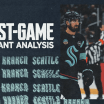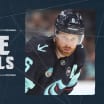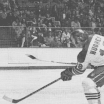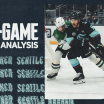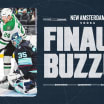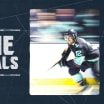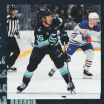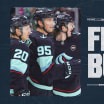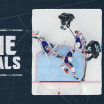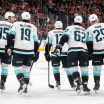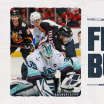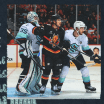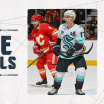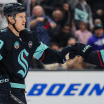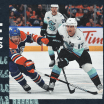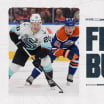There’s understandable confusion I’ve seen among newer NHL fans when it comes to the Kraken’s willingness to spend money.
Spending by pro sports teams on player salaries can be a touchy subject and I’ve never hesitated to call them out whenever they appeared to skimp on quality. But that’s never really been the case with the Kraken, as the team typically spends nearly every dollar permitted under NHL rules.
But those rules in a salary capped league are exactly what causes a lot of the confusion to begin with. The reality: NHL teams currently cannot spend more than $88 million on their entire 23-man roster at any given time.
Other professional circuits, like Major League Baseball, have no such constraints. Sure, MLB operates under a luxury tax threshold in which teams pay penalties for exceeding a pre-set payroll limit. But go ask the Los Angeles Dodgers whether they’d give back multiple World Series rings rather than absorb paying that penalty cost.
So, baseball teams will rightly be scrutinized when they balk at paying Player X and lose him to their free-spending archrivals without adding anybody else. Fans will have every right to question why their team refuses to spend more in a non-capped league and it’s then up to the owner and front office to provide a plausible explanation.
NHL teams aren’t really fighting that same battle. They get a capped top amount and can’t go beyond by even a penny. And that limits the number of high-salaried players they can acquire when building the roster.
It also makes it a benefit whenever a team can keep additional cap room for emergencies, or clear some for future use when already out of contention by offloading pricier contracts and replacing them with less costly ones.
For instance, the Kraken shipped away bottom-six forwards Yanni Gourde and Brandon Tanev at the trade deadline, a duo making a combined $8.4 million between them.
“Ah-ha!” was the consensus rant among some unhappy fans who’d grown to like both players. “The Kraken are going cheap again!”
That conspiratorial thesis was likely bolstered thereafter when the only replacements, added to the fourth line, were trade acquisition Mikey Eyssimont, AHL regular John Hayden, AHL prospect Jacob Melanson and former fourth liner Tye Kartye, back from an AHL rehabilitation stint.
Between them, any two of those players or others on next season’s fourth line would cost roughly a third the money at most that Gourde and Tanev did. If the team stopped there, then some of the gripers might have a point.
But general manager Ron Francis has said repeatedly he isn’t stopping there. Francis plans to use some of the future draft picks acquired in those deals to put together trade packages for higher-end players. Or, he’ll sign higher-end free agents.
Whichever route he takes, he now has extra salary cap room to accommodate the higher wages that good players get paid.
“We’re roughly at $20 million or so in cap space available,” Francis said. “We talked about the draft capital that we require to do that (in trades). So, we’re certainly going to look at the free agent market. And we’re certainly going to look at whether there are any trades teams want to make ahead of the (July) draft, which is kind of the next point where a lot of trades seem to happen.
“So, we’ll be very active on that and try to make our team better.”
Now, nobody is saying the skill sets of those cheaper fourth line replacements are going to be equal or superior to Gourde or Tanev. At least, probably not right away.
But the goal in hockey isn’t to have the best fourth line, where the primary role is checking and setting up the more elite and skilled lines for success. No, the teams that win championships are the ones with elite talent on the top two or three lines.
So, as beloved as Gourde and Tanev were to many, their reduced fourth-line roles and ice time envisioned meant re-signing them at something resembling current wages was never happening.
The Kraken needed the cap space to bring in higher-end, already proven NHL talent this summer to turn things around as quickly as next season while their overall team-building strategy and prospect pipeline comes into better focus. And they now have that room.
Oh yeah, they also traded away popular forward Oliver Bjorkstrand. He differed from Gourde and Tanev because he played on a higher-up line with more wide-ranging responsibilities, wasn’t a pending free agent and had a year of salary on the books next season at $5.4 million.
Well, that salary no longer applies, so that’s $5.4 million in cap room Francis has for this summer, which he was including in his rough $20 million estimate.
The Kraken didn’t really replace Bjorkstrand. But their ever-crowded field of wingers keeps on growing. Newly promoted prospect winger Jani Nyman, who could win AHL Rookie of the Year, earned an extended Kraken stay with three goals and three assists eight games into a stint supposed to last only a handful.
If Nyman is deemed NHL-ready next fall, he’d join one of the top three Kraken lines that currently include team points leader Jared McCann, captain Jordan Eberle, goals leader Jaden Schwartz, 21-goal-scorer Eeli Tolvanen, mid-season trade acquisition Kaapo Kakko and Andre Burakovsky.
There’s room for only six wings on the top three lines and I just gave you seven names if you include Nyman. Not to mention any new, high-end forwards Francis brings in this summer.
So, yeah, the Kraken wings are crowded. They didn’t need an immediate Bjorkstrand replacement because they already have several bumping into one another.
The trick now is to use the found money and try to get players better than Bjorkstrand.
Last summer, when afforded an abundance of cap space, Francis committed $94 million over seven years to Brandon Montour and Chandler Stephenson. Montour has set a Kraken record for goals by a defenseman while Stephenson was leading the team in points before being sidelined by an injury last week.
The Kraken spent the second highest money amount of any NHL team last summer other than Nashville. When the season began, Francis was within about $4,000 of the salary cap limit, which means he might as well have been within four cents of it as the cheapest players cost a minimum of $775,000.
You can’t spend more than he already did.
Another way to gauge NHL team spending is by money allocated to less scrutinized areas not covered by the salary cap.
The Kraken fare very well in these.
They spent $90 million on a practice facility with state-of-the-art training equipment used as a selling tool for free agents. They employ Toronto-based fitness consultant Gary Roberts. Hired a plethora of scouts in Scandinavia and Europe that reaped impressive draft results, including aforementioned Finnish wing Nyman. And built an in-house Kraken Television Network around imported broadcast talent widely considered the best in the league.
This team isn’t cutting financial corners. If anything, it’s been wide open with purse strings. And with the salary cap limit jumping to $95.5 million next season, $104 million after that and $113.5 million from there, expect the financial outlay to get bigger as the team strives to get back to the playoffs and beyond.


